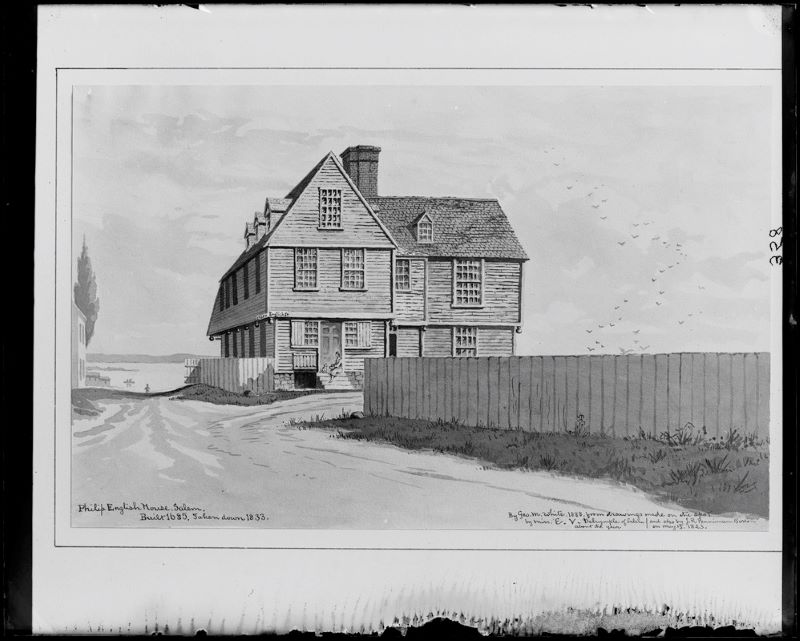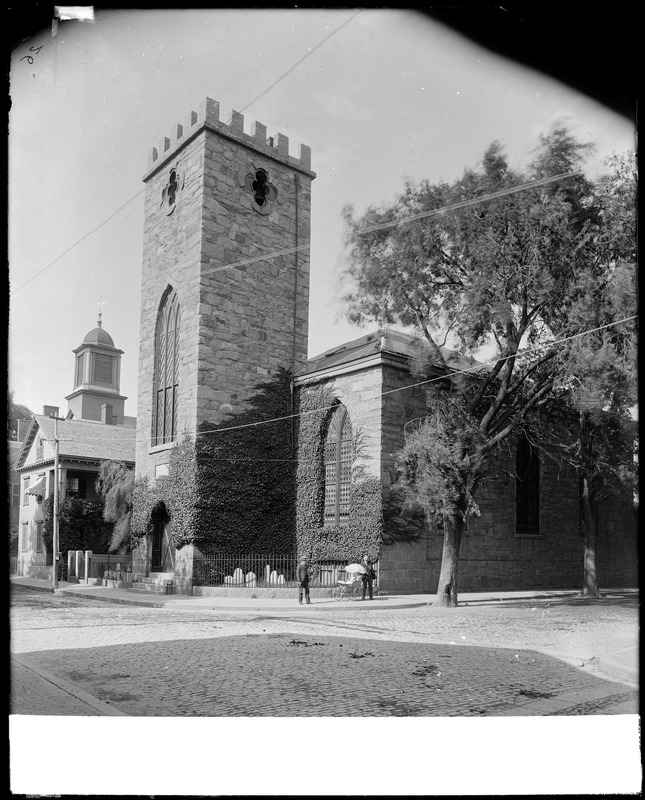Philip English was a wealthy businessman from Salem who was accused of witchcraft during the Salem Witch Trials in 1692.
Philip English’s original name was Philippe d’Anglois and he was born in 1651 on the island of Jersey, in the English channel, to French Huguenot parents.
English emigrated to Salem, Massachusetts in 1670 and became a very successful merchant. He established a thriving international shipping business, traded bond servants from Jersey, and also bought, sold and mortgaged many properties in Salem.
At one point, English owned 14 buildings, a wharf, twenty-one sailing vessels and shares in many others.
In 1675, English married Mary Hollingsworth, the daughter of wealthy merchant William Hollingsworth and later had two daughters.
In 1683, English built a large mansion at what is now 11 Essex Street.
On March 8, 1692, Philip English became a town selectman alongside Israel Porter, Captain John Higginson Jr and Daniel Andrews.
Historians Paul Boyer and Stephen Nissenbaum theorize, in their book Salem Possessed, that when English defeated one of the Putnams in this election for Salem town selectman it might have been what led Thomas Putnam to accuse him of witchcraft shortly after.
It must also be noted though that English was very unpopular in Salem due to his French background, his aversion to paying taxes and his reputation for suing for debts owed to him.
Philip English in the Salem Witch Trials:
On April 18, 1692, an arrest warrant was issued for Philip’s wife, Mary English, and she was promptly arrested at their house the following morning.
Just two days later, on April 20, 1692, an arrest warrant was issued for Philip English after Thomas Putnam and Captain Jonathan Walcott accused him of witchcraft. English managed to evade arrest by hiding in a secret room in his house and then fleeing to Boston.
On May 6, 1692, a second arrest warrant was issued for Philip English when officers searched the house of his business associate George Hollard but they failed to find English because he was hiding behind a sack of dirty laundry.
While English was still on the run, Susannah Sheldon provided testimony against Philip English on May 17 stating that she had been afflicted by English on April 24 at the meeting house with the help of an unknown woman from Boston and a black man who urged her to touch the Devil’s book.
English was eventually arrested on May 30, when it is believed he surrendered because he feared that evading the law was potentially hurting his wife’s case, and he was brought before Judge Jonathan Corwin for his examination the following day.
Since the Salem jail was overcrowded, Philip was sent to the Boston jail to join his wife Mary. The Boston jail allowed its inmates to be released daily on bail with the promise that they would return to the jail at night. Philip and Mary were wealthy enough to afford this luxury so they did this frequently.
On August 8, 1692, William Beale of Marblehead provided testimony against Philip English stating that he was afflicted by English last March when he suddenly became very sick and saw a shadowy figure in his house that resembled Philip English.
After seeing the shadowy figure, Beale said that he soon learned that his son James was sick with smallpox and he died shortly after. Beale stated that his other son George had also died of smallpox in the same house a few months earlier and that he had complained of the feeling of being choked at the time.
On August 21, 1692, the night before they were to return to Salem for trial, Philip and Mary escaped the Boston jail with the help of Reverend Moody and fled to New York.
Escaping jail meant that English not only forfeited his £4,000 pound bond but it also made him subject to other forfeitures to cover his jail fees.
As a result, Sheriff George Corwin and his men went to English’s house and warehouses and confiscated everything they could find, which totaled about £1,183.
Corwin confiscated their furniture, plates, personal wine cellar, lumber, fish, grain, yard goods, shoes, six pigs and a cow from their yard while their neighbors scavenged the rest.
Sometime after the Court of Oyer and Terminer was disbanded in October of 1692 and the trials were starting to wind down, Philip and Mary English returned to Salem to face the charges against them.
On January 12, 1693, Philip English was indicted on charges of witchcraft for afflicting Elizabeth Booth but was not indicted for afflicted Mary Walcott.
Also on January 12, 1693, Mercy Lewis provided testimony against English stating that his spectre was afflicting her in the courtroom that moment while she was testifying against his wife Mary.
The records of both Philip and Mary’s trials are missing but it is believed they were found not guilty since there is no record of them being convicted and they were not executed.
Philip English After the Salem Witch Trials:
On March 2, 1693, Philip English sent a petition to Governor Phips demanding the return of the goods that he says were illegally seized from him by Sheriff Corwin.
As a result, Corwin delivered a list of all the goods he confiscated from English and promised to return everything. When he failed to do so by late April, Phips ordered Corwin to return all of English’s possessions.
The case went to court and on May 15, 1694, the Superior Court found that Corwin’s accounts were “just and true” and also ruled that Corwin and his heirs were not liable for the money, goods and chattels he seized as part of his duties.
That same year, Philip’s wife Mary died in childbirth after giving birth to a son.
On February 26, 1696, despite the court’s ruling, Philip English sued Sheriff Corwin again. The writ demanded that Corwin either pay a bond or appear in court, neither of which Corwin did since he was ill at the time and didn’t have the money to pay. As a result, Corwin was arrested and brought to the Salem jail.
Corwin was later released on bail, which was probably paid by one of his relatives, but then a few months later, on April 12, 1696, he died suddenly of a heart attack at the age of 30, which local legend states was the result of Giles Corey’s curse.
It is rumored that since English’s lawsuit against Corwin was still pending at the time of his death, English threatened to steal Corwin’s body and hold it for ransom.
An article on the New England Historical Society website states that English actually stopped Corwin’s funeral procession, stole the body and ransomed it for silver and jewels but it’s not clear if that actually happened or if it’s just a local legend.
As a result of the ransom threats, it is also rumored that the Corwin family buried Sheriff Corwin’s body in the basement of his house to prevent English from digging it up and stealing it and only later buried the body in the Broad Street Cemetery after the threat had passed.
In 1717, the court finally awarded Philip English £200 in damages for the goods confiscated during the trials, which was only a small fraction of what was taken from him.
On May 31, 1733, English donated a parcel of land on what is now St. Peter’s Street for the construction of the St. Peter’s Church, which was the first Anglican church in the city.
In 1736, English died and was buried in St. Peter’s Church cemetery.
In 1833, St. Peter’s Church was torn down and replaced with a much larger church. Since the new church was bigger than the original one, part of it was constructed over the graves in the churchyard, including Philip English’s grave.
Also in 1833, English’s mansion on Essex Street was demolished. When it was in the process of being torn down, a secret room was discovered in the attic which is thought to have been built after the English’s return to Salem as a safe place to hide if it was ever needed it again.
Sources:
Boyer, Paul and Stephen Nissenbaum. Salem Possessed: The Social Origins of Witchcraft. Harvard University Press, 1974.
Roach, Marilynne. The Salem Witch Trials: A Day by Day Chronicle of a Community Under Siege. Taylor Trade Publishing, 2002
“SWP No. 173: Reversal of Attainder and Restitution (1710 – 1750).” Salem Witch Trials Documentary Archive and Transcription Project, salem.lib.virginia.edu/n173.html#n173.88
“Letter: The History of Salem’s English Street.” Salem News, 13 July. 2015, salemnews.com/opinion/letter-the-history-of-salems-english-street/article_80c99f5e-8c76-543d-82b8-11c10b6ae5d3.html
“Dirty laundry and a friend save Philip English from the Salem Witch Trials.” New England Historical Society, newenglandhistoricalsociety.com/dirty-laundry-and-a-friend-save-philip-english-from-the-salem-witch-trials/
“Mary and Philip English Home, Site of.” Salem Witch Museum, salemwitchmuseum.com/locations/philip-and-mary-english-home-site-of/
“SWP No. 49: Philip English.” Salem Witch Trials Documentary Archive and Transcription Project, salem.lib.virginia.edu/n49.html



I’d be interested to learn if any of the false accusers suffered legal consequences after the Trials? Judge Samuel Corwin issued a later apology: what might have motivated that, apart from remorse? Was there social pressure from Salem descendants of the accused?
There weren’t really any legal consequences against the false accusers, mostly just social consequences. The victims were later awarded restitution to pay back the money they lost in jail fees and confiscations. As I said in the article, English also sued Sheriff Corwin for illegally seizing some of his goods. The accusers were mostly just shunned after the Salem Witch Trials and no one really wanted anything to do with them. The trials became a source of shame for everyone in the town and no one wanted to talk about it afterwards. There was a lot of social pressure on the people involved in the trials to make amends for what they did and Rev. Parris was even forced out of his job as minister by his parishioners because of it.